In our previous blog post we had discussed about What is Sub flow in Salesforce flow.In these blog post we discuss about What is Assignment in Salesforce Flow
Contents
- 1 What is Assignment in Salesforce Flow
- 2 Introduction
- 3 Understanding Salesforce Flow
- 4 What is Assignment in Salesforce Flow
- 5 Types of Assignments
- 6 Creating Assignments in Salesforce Flow
- 7 Use Cases of Assignments in Salesforce Flow
- 8 Benefits of Using Assignments in Salesforce Flow
- 9 Challenges and Solutions
- 10 Advanced Tips for Using Assignments
- 11 Conclusion
- 12 FAQs
What is Assignment in Salesforce Flow
Introduction
Salesforce Flow is a powerful tool that enables users to automate complex business processes within the Salesforce ecosystem. One crucial component of this tool is the concept of “assignments.” Understanding and utilizing assignments effectively can significantly enhance the efficiency and automation capabilities of your Salesforce org.
Understanding Salesforce Flow
Definition and Overview
Salesforce Flow allows users to create applications that automate complex business processes using a visual interface. This includes everything from simple workflows to advanced, multi-step automations that can integrate with other systems and services.
Key Components of Salesforce Flow
- Elements: Building blocks of a Flow, such as assignments, decisions, and loops.
- Resources: Variables, constants, formulas, and collections used within the Flow.
- Connectors: Define the path between elements in the Flow.
What is Assignment in Salesforce Flow
Definition of Assignment
In Salesforce Flow, an assignment is an element that sets the value of variables, collection variables, and record variables. Essentially, it’s used to store data temporarily within a Flow for processing and manipulation.
Role of Assignments in Flow
Assignments play a crucial role in ensuring data is accurately and efficiently managed within a Flow. They allow for dynamic data handling, enabling the Flow to perform actions based on variable values.
Types of Assignments
Variable Assignment
Variable assignments are used to assign a value to a variable. This can be anything from a string to a number or a Boolean.
Collection Assignment
Collection assignments allow for the manipulation of lists or collections of records. This is useful for operations that involve multiple records, such as bulk updates.
Resource Assignment
Resource assignments pertain to other resources like constants, formulas, and global variables.
Creating Assignments in Salesforce Flow
Step-by-Step Guide to Create Assignments
Login to Salesforce Account

Click Gear icon Navigate to Setup
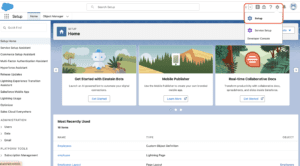
Search Quick find box in Flows
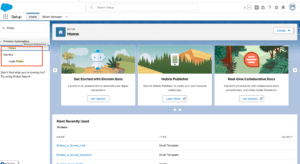
Click New flow
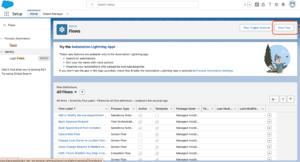
Select Screen Flow
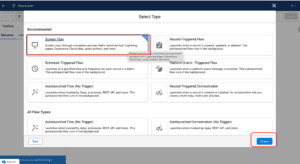
Add elements in Assignment
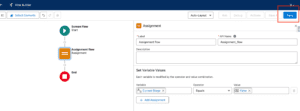
fill details Save
Best Practices for Creating Assignments
- Use Descriptive Names: Ensure variable names are descriptive to avoid confusion.
- Minimize Hardcoding: Use variables and formulas instead of hardcoding values.
- Optimize for Performance: Limit the use of complex assignments in large datasets.
Use Cases of Assignments in Salesforce Flow
Real-World Examples
- Lead Routing: Assign leads to the appropriate sales representatives based on criteria.
- Opportunity Updates: Automatically update opportunity fields based on related record changes.
Industry-Specific Use Cases
- Healthcare: Assign patients to the appropriate care team based on their needs.
- Finance: Automate the assignment of financial tasks based on transaction criteria.
Benefits of Using Assignments in Salesforce Flow
Improved Efficiency
Assignments streamline data handling within Flows, reducing the need for manual intervention and enhancing operational efficiency.
Enhanced Automation
By automating data assignments, businesses can ensure that processes are consistent and reliable, leading to better outcomes and fewer errors.
Challenges and Solutions
Common Challenges
- Complexity: Managing multiple assignments can become complex.
- Performance Issues: Inefficient assignments can slow down the Flow.
How to Overcome These Challenges
- Simplify Assignments: Break down complex assignments into smaller, manageable parts.
- Optimize Performance: Regularly review and optimize your Flows for better performance.
Advanced Tips for Using Assignments
Optimization Techniques
- Batch Processing: Use batch processing for large datasets to improve performance.
- Efficient Data Handling: Use collection variables for bulk operations to reduce processing time.
Advanced Use Cases
- Conditional Assignments: Use decision elements to conditionally assign values.
- Dynamic Assignments: Create dynamic assignments that change based on real-time data inputs.
Conclusion
Assignments in Salesforce Flow are a powerful feature that, when used correctly, can greatly enhance the automation and efficiency of business processes. Understanding how to create, use, and optimize assignments is essential for any Salesforce administrator or developer.
We Want to more about What is Assignment in Salesforce Flow Click Here
FAQs
What is the main purpose of assignments in Salesforce Flow?
Assignments in Salesforce Flow are used to set and manage the values of variables, enabling dynamic data handling within automated processes.
How do I create a variable assignment in Salesforce Flow?
To create a variable assignment, add an Assignment element in Flow Builder, set the variable, and define its value.
Can assignments in Salesforce Flow handle complex data?
Yes, assignments can handle complex data, including lists and collections of records, making them suitable for a wide range of use cases.
What are some common mistakes to avoid when using assignments?
Common mistakes include not using descriptive variable names, hardcoding values instead of using variables, and creating overly complex assignments.
How can I optimize assignments for better performance?
To optimize assignments, break down complex assignments, use batch processing for large datasets, and regularly review and optimize your Flows.
In our next blog post we will discuss about What is Decision Element in Salesforce Flow

2 thoughts on “What is Assignment in Salesforce Flow”